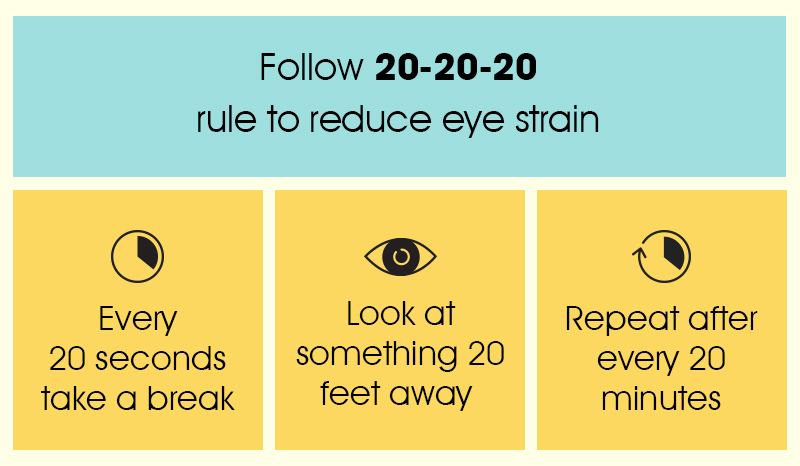Of all the senses, sight must be the most delightful.
-Helen Keller
Your eyes make the world visible to you. They are your doors to the world. And just like any other muscle, our eye muscle also requires some stretching and exercising. Strengthening our eye muscles is possible and helpful. Now, with technology taking over the world, our eyes, more than ever, need relief from soreness and dryness due to screens. Prolonged periods of screen time also takes its toll on our eyes.
A little time spent on them now will reap you huge rewards in the long run. Not only will these efficient, quick eye exercises help maintain healthy eyes but can also aid in relieving headaches due to overworked eye pressure, eliminate errors, boost your productivity, and even reduce the risk of glaucoma.
When should I exercise my eyes?
You can practise these eye exercises regardless of the symptoms you are experiencing. Strengthening your eyes are always a wiser choice than not caring for them. But particularly follow the routine of eye exercises if you find yourself undergoing the following symptoms:
- Crossed eyes (Strabismus)
- Eye drifting inward or outward
- Double vision
- Blurred vision
- Lazy eyes (Amblyopia)
- Poor binocular vision
- Difficulty focusing while reading
- Tired eyes (Eye strain)
- Acute light sensitivity
When doesn’t it work?
There are some conditions, however, that do not have sufficient scientific backing.The eye exercises (visual training) may have little to no effect on the following eye disorders:
- Dyslexia
- Learning disabilities
- Eye spasms
- Refractive errors
- Paralysed eye muscle
- Intensive blinking
- Poor sports vision
The beauty of eye exercises is that they can be practised anywhere, anytime and it’s only a matter of seconds before you’re already finished. Read on to know which symptom to soothe with which exercise.
Visual training for temporary eye irritation
After continued periods of strained vision (thanks to the blue light emitted by screens), your eyes get strained, dry and you may even suffer from headaches. Also, prolonged periods of computer use can lead to higher risks of eye and visual disorders development. Simple yet effective visual exercises are known to soothe your eyes from temporary irritations.
The following exercises are, especially, for people who end up staring at screens all day long and suffer from eye fatigue:
Move your eyes – This exercise is to ensure that your eyes move to full range of possible vision. People nowadays spend most of their times looking straight ahead, at their screens, not moving their eyeballs completely. It is recommended to exercise our eyes’ full spectrum of motion and following exercise helps you do that. Minimum requirements for this exercise is sitting upright and facing forward. Now, without moving your head, look up, down, left and right. Repeat this cycle multiple times as your eyes feel more comfortable and less strained.
Rest your vision – Continuously staring at screens is harmful, remember to look up and focus on distant objects periodically. Your vision needs to focus on objects that are at least three meters away, it can be a framed picture you stare at or a tree you see outside the window. Maintain your focus on that object for a short span of time before looking back at the screen in front of you.
20-20-20 rule – Another heavily popular eye exercise is called the “20-20-20” rule, wherein an individual looks up at a distant object that’s 20 feet (six meters) away, every 20 minutes for at least 20 seconds. You can use reminders on your computer or phone to positively follow this rule.

Basic eye strengthening exercises
Zoom

An excellent and effective eye exercise is called zooming. As the name suggests, you zoom on an object to shift your vision’s focus.
You can do this while sitting or standing, all you have to do is stretch out your arm straight and point your thumbs upward.
Now stare at your thumb and, while bending your arms, gradually bring it closer to your eyes, hence zooming on the thumb to bring it to focus.
Palm heat

This eye exercise is the easiest and also provides instant relief from eye strain. Rub your hands vigorously such that your palms are warm.
Close your eyes and gently place your hands on your eyes. Keep your hands on your eyes until your palms are devoid of all the heat. The warmth in your hands is slowly transferred to your eyes, leaving you relaxed and refreshed.
After plenty of screen time, the darkness relieves your eyes. This exercise can be repeated two to three times.
Rotate

Like one shifts and rotates their neck for tension relief, you can do the same with your eyes for relaxation. Look at your extreme right side and then gradually look to your left.
In addition to that, rotate your eyeballs clockwise and then anticlockwise. This wonderful little trick pumps up blood in your tiny eye muscles for healthy eye repairment.
Blink

As the name suggests, this exercise involves blinking. Make yourself comfortable and blink repeatedly 10-15 times. After doing so, relax your eyes by closing them for 20 seconds.
You can practice this 4 to 5 times a day. In addition to this, encourage yourself to blink more effortlessly and frequently. Not only does blinking relax eye muscles, it also serves the function of lubricating and sanitising your eyes with tears.
Eight figure

This exercise requires you to sit with legs stretched out in front of you. Place your right hand on your right knee and stretch your left hand, keeping your elbows straight, with your thumb pointing towards the sky.Try not to move your head and concentrate on the thumb.
Now, make a figure of the number eight with your thumbs while keeping your eyes fixated on your thumb. It is advisable to repeat this exercise in clockwise and anticlockwise directions for 5 times each. Go ahead and do the same with your right hand next.
Palming

This exercise requires you to either lay on the floor or simply sit down. All you have to do is close both your eyes with the palms of your hands and without adding any pressure on your eyelids, cross the fingers of one hand over the other on your forehead.
Having done that, idealistically one sees a pitch black field of darkness, indicating perfect relief and complete leisure.
Contrarily, visions of bright colours, light or patches of gray can mean you are not devoid of stress and tension. If you witness any of these illusions, instead of forcing yourself to see the darkness (which would cause even more stress), passively envision a favourite memory of yours that helps put your mind at ease.
Don’t forget to keep your shoulders and neck relaxed all this while. Practise palming frequently and for long durations of time for effective muscle relaxation and sight benefit.
Swing

Exercising your body has tremendous benefits and this particular exercise that involves the entire body doesn’t only relieve stress and fatigue but also increases your eyes’ mobility. Keeping your legs 12 inches apart, stand straight looking ahead.
Now rotate your entire body to the left and while shifting your bodyweight onto your left leg, lift your right heel from the floor. Keeping your neck and shoulders straight, swing to the opposite side by throwing your weight onto your right foot this time. This swinging motion provides a 180 degrees arc movement to your eyes.
Try not to focus or fixate your vision on anything specific and simply stay in a relaxed stance. You should make around 30 arcs per minute.
Additionally, do these sets twice in a day and finish around 100 swings from side to side. If done before bedtime, this visual training exercise can help avoid eye strain caused during sleep.
Sun therapy

Although there’s no concrete scientific proof that ‘sunning’ helps with vision improvement or relaxation, plenty of people have documented the positive effects of the sun on their eyes.
Remember, this exercise should only be done with eyes closed. All you have to do is close your eyes and sit or stand in sunlight. The rays of sun penetrate and relieve the pressure off of your eyelids.
Occasionally rotate your head from side to side or make an imaginary circle around the sun, with your nose so as to avoid any possible eye strain. A few minutes in the morning are sufficient to help. Practice deep breathing and avoid squinting.
Shifting

This exercise involves rapid eye movements. You have to force your eyes to continuously make small-scale shifts in vision without actually seeing everything clearly.
You want to consciously try and perceive everything that comes into view and just get a sense of the objects. Swift eye-shifting is known to be extremely beneficial as vision loss is often attributed to lack of eye motion.
This exercise also relaxes eye muscles and reduces any strain on them, just like all of the other eye exercises. People with visual defects like farsightedness, nearsightedness, astigmatism and squint often find this exercise most favourable.
Following these simple yet effective eye exercises can help give your eyes the nourishment, exercise and comfort they’ve always been asking for.







